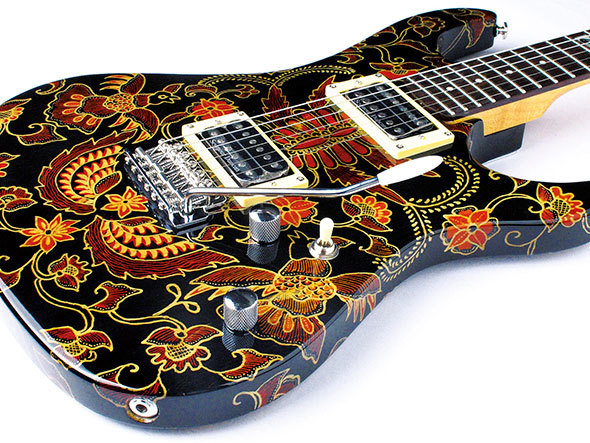In the crowded guitar market, G&B’s beautiful, handmade goods stand out from the others for their uniqueness. G&B is famous for its electric and bass guitars, which are adorned with batik patterns. Those batik motifs are painstakingly created by using the age-old, time-consuming process that is used in making traditional hand-drawn batik tulis textiles, which includes the usage of canting (a copper vessel with a spouted nib) and malam (wax). At G&B, each guitar is a work of art.

Music and art have always been Haryo Sasongko’s particular interests. With his artistic batik guitars, Haryo ensures the survival of traditional Indonesian craft, while at the same time creating a sustainable source of income for the batik artisans. Haryo entrusts the job of making beautiful, intricate batik patterns on his goods to batik artists in Yogyakarta, which is considered home to many of the finest batik artists.
“We do not call them batik makers, instead, we address them as artists as each batik guitar is, indeed, an artwork,” says Haryo who refers to those batik artists as partners rather than employees.
Even though the majority of G&B’s merchandise features various Javanese batik patterns, this brand actually also features lesser-known designs from other areas in Indonesia, such as Aceh, Kalimantan (Borneo) and Papua, among others.
G&B stands for Guitar Batik as well for Guitar & Bass. The story of G&B started when Haryo’s wife came up with the idea of making batik guitars after her visit to Bantul region in Yogyakarta, where she saw batik artisans creating batik patterns on wooden goods, such as masks and wall decorations. She shared the idea with her husband, and the rest, as they say, is history.

However, as a pioneer in this field, there was no guidance for Haryo on how to make a batik guitar, which bears striking resemblance to batik textiles in appearance. “The project has indeed demanded lots of investment of money, time and effort,” says Haryo.
The lengthy manual process of creating the exquisite batik guitars is very complicated. Applying the time-consuming batik tulis process onto the wooden musical instrument is not an easy task (many, although not all, wooden goods in the market are simply painted with batik pattern, rather than going through the traditional batik tulis process).
It took 30 years of hard work and trial-and-error process since its inception, before the project finally came to fruition; in 2011, Haryo established PT Gitar Batik Produktama. Currently, Haryo’s daughter, Putri Sulistyowati, is the CEO of that company.
The Ministry of Industry Indonesia issued a statement letter in 2013, certifying G&B as the first guitar brand that applies the batik tulis process on the body of its electric guitars. In 2017, the Indonesian Museum of Records (MURI) awarded G&B as a brand that created the first batik guitar by using traditional batik tulis process.

Batik tulis is the term that is used to describe hand-drawn batik textiles, painstakingly made by using canting (a copper vessel with a spouted nib) and malam (wax). G&B’s famous batik tulis guitars are created with this age-old, time-consuming process that is used in making traditional hand-drawn batik tulis textiles as well.
Just like in making batik tulis cloths, the manual process of waxing, dying and drying, must be repeated meticulously for each colour, one by one. Hence, if a guitar has say, 6 colours in total, it means the batik artist has to repeat the whole procedure from waxing to drying 6 times.
There are three techniques to make batik guitars. The first and most complicated one has been described above. The second way is to adhere a high quality batik tulis textile neatly onto the guitar, while the third one sees the artist painting the batik pattern on the guitar by using oil paint or wood paint – this process naturally does not involve the usage of canting and malam. The different techniques result in three kinds of beautiful batik guitars; each of them differs from the other in appearance – each has its own artistic merits.
Over the years, G&B has been introducing new batik patterns and products. Today, besides wooden musical instruments, this brand also offers electric batik guitars and bass guitars, which combine the beauty of wood and bamboo. Batik drum has been included in its product range, too.

Due to their uniqueness and quality, G&B guitars are highly valued by musicians and even collectors who do not play guitar and buy the musical instruments for the sake of their artistic value.
Batik guitars can also appropriately serve as prestigious, unique souvenirs. In 2013, Haryo went to the United States of America and personally handed two guitars to Dr. Ir. Haryo Winarso, the Attaché for Education & Culture of the Indonesian Embassy in the U.S as souvenirs. At the end of his term in 2014, he gave one of those batik guitars, called ‘Perisai Aceh’, as a souvenir to President Barack Obama at the White House.
G&B guitars and bass guitars start at US$ 1,000. The guitars and bass guitars from the brand’s second line called Anglo (charcoal brazier that is used in the traditional process of making batik tulis) have price tags in Rupiah, which start at Rp 6,500,000.
“Each batik guitar is one of a kind. They are not mass-produced goods. And since each batik is done manually, no piece is exactly the same, even if the artists use the same batik pattern and technique,” says Putri.

Haryo, a guitar musician himself, ensures that his batik musical instruments are not only beautiful, but also adhere to quality guitar standards – G&B’s tag line is: Great sound and beautiful batik. “We are trying our best to present Indonesian heritage to the world,” says Putri.
Through their artistic guitars, which have won the hearts of Indonesians and foreigners alike, Haryo and his family share their love of batik and music with the world, while at the same time showcase the cultural richness of Indonesia.

In conjunction with National Batik Day, G&B will launch a book entitled “Gitar Batikku Dari Jogya Menuju Gedung Putih” (My Batik Guitars From Jogya to The White House) in December 2017. This book, which is packed with colourful photos of G&B batik musical instruments, will take the readers on a fascinating journey into the history of G&B.
House of G&B / Poetsoe Creative Space & Café:
Jl. EE # 52
Menteng Dalam, Tebet, Jakarta Selatan
T: +62 21 828 0360
WA: +62 812 12 080907/+62 812 9399 2371
W: www.gnbguitars.com
E: kongkogb@yahoo.com & putsulistyowati@gmail.com
IG: @gnbguitars
FB: Haryo Kongko Sasongko






